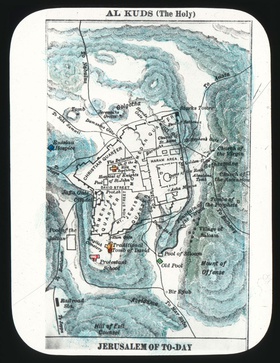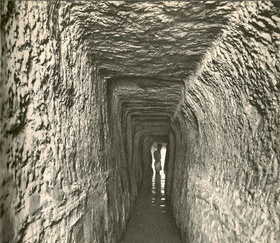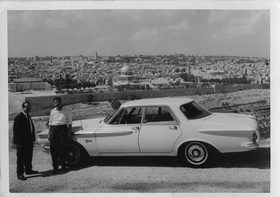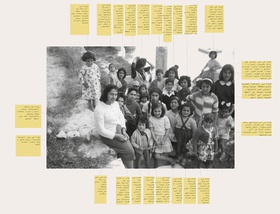Publications
The Jerusalem Show
A View from the City: Tina Sherwell
Fractured City
A View From Jerusalem
Tina Sherwell
This year's Qalandiya International theme is archives, or borrowing the exhibition statement's words: 'the narratives and daily lives of nations and communities, and archival practices take on a particular resonance in our collective search to understand our past, present and to shape our future.' As the statement continues, an unprecedented archive fever has swept across the region, which is why the topic has this year taken centre stage.
Of course, the importance of archives and the urgency with which to compile, maintain and preserve them, has accompanied Palestinians across the decades owing to a legacy of dispossession. Under this broad theme, the Jerusalem Show VII, titled Fractures and curated by Basak Senova, also explores the question of archives through different resonances among artist practices both Palestinian and international, weaving art works across the urban terrain of the old city of Jerusalem in thirteen different locations from a historic bathhouse, to local shops, an Austrian hospice, to the Khalidi library and the galleries of Annadiel and Al-Ma'mal: formerly a bookbinder's shop and a tile factory respectively. Placing less emphasis on the city's religious sites, for which it is arguably most famous, the locations employed for the Jerusalem Show shine a light on the many other historic sites that exist here in Jerusalem, and which reveal the city's varied cultural legacy, not to mention its important position as a place of knowledge, recreation and trade, interwoven with numerous family histories.
Yet, in the severe political context of Jerusalem today, such sites have been forgotten, as this historic city's arteries are choked by Israeli policies restricting movement and growth, which severely hamper social development. These accumulative Israeli policies towards the city and particularly the Palestinian population, have continued to intensify throughout the past decades, and have served to work twofold: to prevent the creation of a holistic community while erasing out traces of the past. This is most strikingly experienced when one walks through Jerusalem with people who have lived here for generations, listening to them describe how the city streets were once. This ritual of recollection and detailed description of what once was has become a crucial part of the Palestinian memory of Jerusalem especially in the face of occupation and its apparatus, which continually transform the city space in line with Israel's political agenda. The importance of archives, therefore, is paramount: personal, institutional, oral, visual, the need to re-visit, mine and engage with archival material however fragmented has become a cornerstone of Palestinian identity but can get forgotten in the daily struggle to survive occupation. Through this process of archiving, the rich detail of life in the past comes to the foreground, and when artists and creative practitioners undertake this task, the results are haptic. They engage our senses and produce threads that communicate a relationship between past and present, which is pivotal when a community's history is continually being targeted with policies of erasure which target each individual as well as the physical urban and rural landscape and historic sites.
In this light, what does it mean to undertake an exhibition like the Jerusalem Show VII at this time? It is significantly challenging to pursue cultural interventions in a city drenched with tension. You can feel it the moment you enter, as so many people have noticed accompanied by continued military and police presence. Today, Jerusalem has become a severely isolated fortress city: the population of the West Bank are forbidden from reaching the city centre and draconian measures operate over the city's Palestinian 'residents', who encounter the stringent laws on movement, trade, residency on a daily basis, in which every activity such as getting to work, going to school is met with series of restrictions and regulations. Any attempt at political protest is swiftly followed with night raids and arrests that serve to cast a blanket of silence over the population. Most Palestinians live in parts of the city that are severed and isolated from each other through checkpoints and the partition wall, which has further unravelled a sense of collective community over the past 14 years, emptying a city that was once a hub of cultural activity and an epicentre of creativity, discussion and debate. In such as context the Jerusalem Show and Qalandiya International attempt to challenge this isolation and fragmentation through a programme which involves, 13 Palestinian cultural institutions with 66 events in 15 cities and villages, over 26 days, with the participation of over 100 Palestinian and international artists, producing and participating in exhibitions, tours, symposiums, film screenings, performances, workshops and book launches.
After all, for decades East Jerusalem was an important cultural centre, with gallery spaces, cinemas, cultural centres, and theatres. Zahra Street, for example, hosted the gatherings of intellectuals and artists in the 1960s and 70s, while Al Hakawati Theatre was a hub of cultural resistance activities in the 1980s with art exhibitions, theatre shows and discussions. The segregation of the city within itself and with the West Bank has served to cut all lifelines to the city. Narrowing of roads, the introduction of the Israeli light-railway, a building ban for Palestinians, checkpoints, partition walls, continually heavy police and military presence materialize in an aging historic city is left bereft a city that becomes a ghost town by night. Once filled with people coming to the city for work, leisure, trade, religion and tourism, such activity has significantly decreased; certain crafts have diminished; public baths have closed. All emphasis has been placed on the city's religious significance, which sidelines its rich history as a cosmopolitan city interwoven into the fabric of the Arab World.
As such, cultural institutions such as the Al-Ma'mal Foundation and Al Hoash Art Court now engage not only in severe struggles to survive, facing often insurmountable challenges with funding, rent charges and enabling Palestinians of the West Bank to attend their events, but in the struggle to create spaces through which a communal culture can exist. Of course, in such contexts it is important to see beyond the here and now of occupation and really look at the undertakings of creative initiatives spearheaded by the art and cultural institutions in Jerusalem through their programmes, interventions and exhibitions. Key in this as Jack Persekian highlighted in the press conference of QI is the need not to be in continual position of re-action to Israeli occupation but to set our own agendas and the importance of engagement with each other and the public. Qalandiya International is a grassroots approach: this biennial exhibition is not organized by the city or the government but by independent institutions. It is an attempt to bring together the collective efforts of visual art institutions throughout the territory, with a joint programme of art initiatives that weaves itself across Jerusalem, Gaza, West Bank and Haifa, Through such joint co-operations, initiatives like Qalandiya International endeavour to challenge and to re-suture the geographical segregations that divide Palestinians. After all, art enables us to pause and see the world differently, and it is through art that new realities can be imagined and created, even if only temporarily.
Recently, I was asked what the public reaction to Qalandiya International would be this year. Would there be a large public turn out? Are the public thirsty for cultural events? Has contemporary art practice become an elite activity? Will public engage? Or is there an atmosphere of apathy, with the odds stacked up against the pressures of daily life under occupation, political instability especially in a political context accompanied by continually skewed media representations? There is a deep uncertainty and sense of foreboding since the assault on Gaza in the summer of 2014. Yet, these uncertainties make questions hard to answer. We exist in a small crowded place, which one experiences as a continually shifting plateau: indeed, as Edward Said suggests, 'Cover a map of Palestine with the legends, insignia, icons and routes of all the peoples who have lived there, and you will have no space left for the terrain.'[1] But the Jerusalem Show VII serves as a reminder, or indeed, a wake up call, to delve into our relationship with the city and its layered histories; for us not to just accumulate archives but to examine, reflect on, and listen to archives however fragmented they are. We must revisit a past that is continually confiscated by others.
Nevertheless, after the assault on Gaza in the summer of 2014, there was significant discussion between 13 organizations about where to go from here, in light of such massive loss of life and destruction. The collective decision was to continue to pursue programmes such as Qalandiya International. The reason being these events propose the important strategy of steadfastness, something heralded by the Palestinians for decades.
And so, with this edition of Qalandiya International, there is an undoubtedly rich programme of interventions from participating artists, with significant debates scheduled around the question of archives. These include a three day symposium organized by the Palestine Museum, Ramallah Municipality, Khalil Sakakini Culture Centre, A.M Qattan Foundation and Al Hoash Art Court including local and international participants such as Michael Rakowitz, Doreen Mende, Salim Tamari, Ann Butler, Oraib Toukan among others, titled 'Qalandiya Encounters', which will explore themes from self-historicalization to the first intifada. The 'Off Qalandiya Forum' is a one-day forum that aims at unpacking the role of 'visual art' in the current crisis of the Palestinian Liberation, the shift in societal values, as well as the relationships between cultural actors, the Palestinian and the international audiences, curated by Alia Rayyan and Yazid Anani. Then there is the 'Location, Location, Location' symposium, which is organized by the International Academy of Art, Palestine, in which Tirdad Zolghadr and Emily Jacir will be exploring the question of Location with speakers Sarah Pierce, Gerard Byrne and Uzma Z. Rizvi. The aim here is to discuss the tired language of 'centres versus peripheries', the challenges of institutional agency, as well as the representational burdens and blessings of contemporary art. In the end, can an intelligent definition of the 'local' escape the quandaries of representation?
At the same time, the theme of archives itself is explored from a kaleidoscope of perspectives through artists practices, artworks, and site specific installations with use of historic locations, screenings and performances. This serves to bring the archive of location, history of belonging and place to the forefront, placing archives a centre stage particularly in the city of Jerusalem whose inhabitants live under the daily iron fist of occupation which has a corrosive affect on population. The Jerusalem Show – through its form of not confining itself to the gallery space, takes us on a visual and sensual journey through the city, winding its way through passageways and unfolding new narratives of untold stories that probe us to question our relationship to our many pasts. 'Fractures' accurately describes the Palestinian condition: the breaks, tears, and sutures: these are not pristine archives, after all – Palestinian archives contain experiences of war, destruction, confiscation and scattered loss. They are living archives that are shared through exhibitions and events.
Of course, when it comes down to that question: how will such initiatives as the Jerusalem Show and Qalandiya International work towards producing new realities in such a fractured space as Jerusalem? Here, Beshara Doumani's words linger like a spectre:
Palestinians are still incapable of stopping the continued and accelerating erasure of the two greatest archives of all: the physical landscape and the bonds of daily life that constitute an organic social formation.
Yet, in this multitude of events and the creation of interventions in a city under occupation, the spirit of solidarity and co-operation among 13 organizations amidst the challenges is an attempt to put a pause in this escalation described by Doumani, even if only temporarily, and there is no doubt that what these endeavours will remain as a testimony for the archives of tomorrow.
[1]Edward Said, After the Last Sky: Palestinian Lives, Faber and Faber, London, 1986 p.63.




